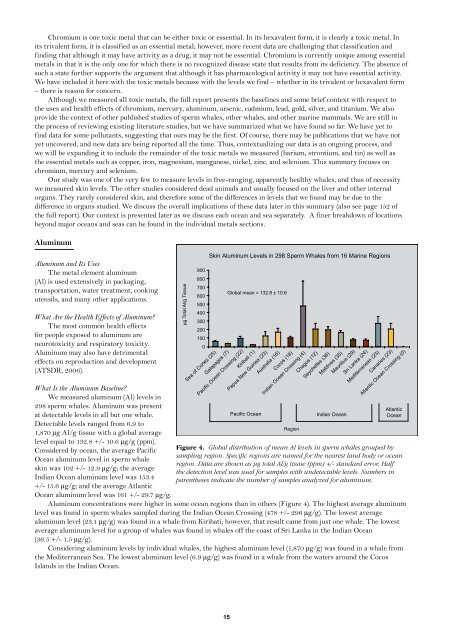Voyage of the Odyssey executive summary - Ocean Alliance
Voyage of the Odyssey executive summary - Ocean Alliance
Voyage of the Odyssey executive summary - Ocean Alliance
You also want an ePaper? Increase the reach of your titles
YUMPU automatically turns print PDFs into web optimized ePapers that Google loves.
Chromium is one toxic metal that can be ei<strong>the</strong>r toxic or essential. In its hexavalent form, it is clearly a toxic metal. In<br />
its trivalent form, it is classified as an essential metal; however, more recent data are challenging that classification and<br />
finding that although it may have activity as a drug, it may not be essential. Chromium is currently unique among essential<br />
metals in that it is <strong>the</strong> only one for which <strong>the</strong>re is no recognized disease state that results from its deficiency. The absence <strong>of</strong><br />
such a state fur<strong>the</strong>r supports <strong>the</strong> argument that although it has pharmacological activity it may not have essential activity.<br />
We have included it here with <strong>the</strong> toxic metals because with <strong>the</strong> levels we find – whe<strong>the</strong>r in its trivalent or hexavalent form<br />
– <strong>the</strong>re is reason for concern.<br />
Although we measured all toxic metals, <strong>the</strong> full report presents <strong>the</strong> baselines and some brief context with respect to<br />
<strong>the</strong> uses and health effects <strong>of</strong> chromium, mercury, aluminum, arsenic, cadmium, lead, gold, silver, and titanium. We also<br />
provide <strong>the</strong> context <strong>of</strong> o<strong>the</strong>r published studies <strong>of</strong> sperm whales, o<strong>the</strong>r whales, and o<strong>the</strong>r marine mammals. We are still in<br />
<strong>the</strong> process <strong>of</strong> reviewing existing literature studies, but we have summarized what we have found so far. We have yet to<br />
find data for some pollutants, suggesting that ours may be <strong>the</strong> first. Of course, <strong>the</strong>re may be publications that we have not<br />
yet uncovered, and new data are being reported all <strong>the</strong> time. Thus, contextualizing our data is an ongoing process, and<br />
we will be expanding it to include <strong>the</strong> remainder <strong>of</strong> <strong>the</strong> toxic metals we measured (barium, strontium, and tin) as well as<br />
<strong>the</strong> essential metals such as copper, iron, magnesium, manganese, nickel, zinc, and selenium. This <strong>summary</strong> focuses on<br />
chromium, mercury and selenium.<br />
Our study was one <strong>of</strong> <strong>the</strong> very few to measure levels in free-ranging, apparently healthy whales, and thus <strong>of</strong> necessity<br />
we measured skin levels. The o<strong>the</strong>r studies considered dead animals and usually focused on <strong>the</strong> liver and o<strong>the</strong>r internal<br />
organs. They rarely considered skin, and <strong>the</strong>refore some <strong>of</strong> <strong>the</strong> differences in levels that we found may be due to <strong>the</strong><br />
difference in organs studied. We discuss <strong>the</strong> overall implications <strong>of</strong> <strong>the</strong>se data later in this <strong>summary</strong> (also see page 152 <strong>of</strong><br />
<strong>the</strong> full report). Our context is presented later as we discuss each ocean and sea separately. A finer breakdown <strong>of</strong> locations<br />
beyond major oceans and seas can be found in <strong>the</strong> individual metals sections.<br />
Aluminum<br />
Aluminum and Its Uses<br />
The metal element aluminum<br />
(Al) is used extensively in packaging,<br />
transportation, water treatment, cooking<br />
utensils, and many o<strong>the</strong>r applications.<br />
What Are <strong>the</strong> Health Effects <strong>of</strong> Aluminum?<br />
The most common health effects<br />
for people exposed to aluminum are<br />
neurotoxicity and respiratory toxicity.<br />
Aluminum may also have detrimental<br />
effects on reproduction and development<br />
(ATSDR, 2006).<br />
What Is <strong>the</strong> Aluminum Baseline?<br />
We measured aluminum (Al) levels in<br />
298 sperm whales. Aluminum was present<br />
at detectable levels in all but one whale.<br />
Detectable levels ranged from 6.9 to<br />
1,870 μg Al/g tissue with a global average<br />
level equal to 132.8 +/- 10.6 μg/g (ppm).<br />
Considered by ocean, <strong>the</strong> average Pacific<br />
<strong>Ocean</strong> aluminum level in sperm whale<br />
skin was 102 +/- 12.9 μg/g; <strong>the</strong> average<br />
Indian <strong>Ocean</strong> aluminum level was 153.4<br />
+/- 15.6 μg/g; and <strong>the</strong> average Atlantic<br />
<strong>Ocean</strong> aluminum level was 161 +/- 29.7 μg/g.<br />
µg Total Al/g Tissue<br />
900<br />
800<br />
700<br />
600<br />
500<br />
400<br />
300<br />
200<br />
100<br />
0<br />
Skin Aluminum Levels in 298 Sperm Whales from 16 Marine Regions<br />
Aluminum concentrations were higher in some ocean regions than in o<strong>the</strong>rs (Figure 4). The highest average aluminum<br />
level was found in sperm whales sampled during <strong>the</strong> Indian <strong>Ocean</strong> Crossing (478 +/- 296 μg/g). The lowest average<br />
aluminum level (23.1 μg/g) was found in a whale from Kiribati; however, that result came from just one whale. The lowest<br />
average aluminum level for a group <strong>of</strong> whales was found in whales <strong>of</strong>f <strong>the</strong> coast <strong>of</strong> Sri Lanka in <strong>the</strong> Indian <strong>Ocean</strong><br />
(36.5 +/- 1.5 μg/g).<br />
Considering aluminum levels by individual whales, <strong>the</strong> highest aluminum level (1,870 μg/g) was found in a whale from<br />
<strong>the</strong> Mediterranean Sea. The lowest aluminum level (6.9 μg/g) was found in a whale from <strong>the</strong> waters around <strong>the</strong> Cocos<br />
Islands in <strong>the</strong> Indian <strong>Ocean</strong>.<br />
15<br />
Global mean = 132.8 ± 10.6<br />
Sea <strong>of</strong> Cortez (25)<br />
Galapagos (7)<br />
Pacific <strong>Ocean</strong> Crossing (22)<br />
Kiribati (1)<br />
Papua New Guinea (23)<br />
Australia (16)<br />
Cocos (18)<br />
Indian <strong>Ocean</strong> Crossing (4)<br />
Chagos (12)<br />
Seychelles (36)<br />
Maldives (35)<br />
Mauritius (29)<br />
Sri Lanka (24)<br />
Mediterranean (23)<br />
Canaries (23)<br />
Atlantic <strong>Ocean</strong> Crossing (0)<br />
Pacific <strong>Ocean</strong> Indian <strong>Ocean</strong><br />
Region<br />
Atlantic<br />
<strong>Ocean</strong><br />
Figure 4. Global distribution <strong>of</strong> mean Al levels in sperm whales grouped by<br />
sampling region. Specific regions are named for <strong>the</strong> nearest land body or ocean<br />
region. Data are shown as µg total Al/g tissue (ppm) +/- standard error. Half<br />
<strong>the</strong> detection level was used for samples with undetectable levels. Numbers in<br />
paren<strong>the</strong>ses indicate <strong>the</strong> number <strong>of</strong> samples analyzed for aluminum.


